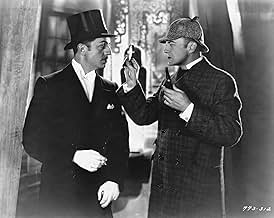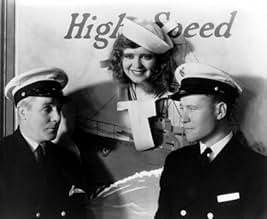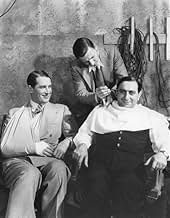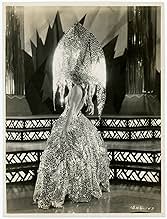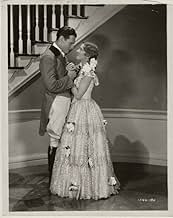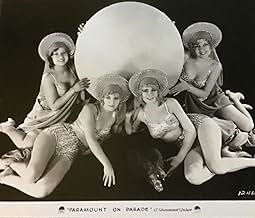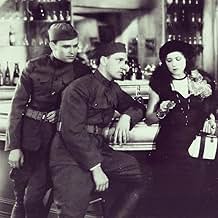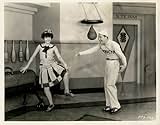Ajouter une intrigue dans votre langueA musical revue that has Paramount stars and contract-players doing unrelated short sketches and elaborately staged song-and-dance numbers like a duet on a giant cuckoo clock and Clara Bow s... Tout lireA musical revue that has Paramount stars and contract-players doing unrelated short sketches and elaborately staged song-and-dance numbers like a duet on a giant cuckoo clock and Clara Bow singing aboard a navy vessel.A musical revue that has Paramount stars and contract-players doing unrelated short sketches and elaborately staged song-and-dance numbers like a duet on a giant cuckoo clock and Clara Bow singing aboard a navy vessel.
- Réalisation
- Scénario
- Casting principal
- Récompenses
- 3 victoires au total
Charles 'Buddy' Rogers
- Buddy Rogers - Episode 'Love Time'
- (as Buddy Rogers)
Avis à la une
"Paramount On Parade" is both a musical revue and a collection of skits by Hollywood stars who can sing and some who cannot. The entertainment value is uneven as some of their stints in front of the camera range from pretty good to mediocre, from Maurice Chevalier to George Bancroft, whose forte was gangster roles. The movie was an excuse for Paramount to showcase as much of their stable of stars as they could assemble, and there were quite a lot of them. I understand that there were a spate of star revue-type pictures produced around the start of the sound era, and this was another one in that mold.
The main reason to see this picture in 2010, I found, was as a museum piece, watching old stars that I had only heard of. Hadn't seen much of Mitzi Green to speak of, ditto Skeets Gallagher, and had never seen Harry Green before. From that standpoint it was fascinating, but maybe not for moviegoers older than me. There was a good skit with four old-time movie sleuths, Warner Oland, William Powell, Clive Brook and Eugene Palette (who was more of a movie dim-witted cop).
On the IMDb site it is clocked at 77 minutes but at Capitolfest in Rome,N.Y. (8/10), a 102 minute 35mm print restored by the UCLA film department was shown which made it extra special.
The main reason to see this picture in 2010, I found, was as a museum piece, watching old stars that I had only heard of. Hadn't seen much of Mitzi Green to speak of, ditto Skeets Gallagher, and had never seen Harry Green before. From that standpoint it was fascinating, but maybe not for moviegoers older than me. There was a good skit with four old-time movie sleuths, Warner Oland, William Powell, Clive Brook and Eugene Palette (who was more of a movie dim-witted cop).
On the IMDb site it is clocked at 77 minutes but at Capitolfest in Rome,N.Y. (8/10), a 102 minute 35mm print restored by the UCLA film department was shown which made it extra special.
A couple of years into the Talkie revolution, several studios put on feature-length revues to promote their brand, of which Paramount's effort seems to have been better than most, even though it has not worn particularly well since. (Also the print I watched was notably fuzzy and dim.)
Deservedly, it gives generous exposure to Maurice Chevalier, who had just rescued the studio's fortunes with his Ruritanian romance 'The Love Parade', just as the Wall Street crash was threatening to ruin Hollywood. In particular, his energetic closing act, 'Sweeping the Clouds Away', accompanied by an endless line of leggy beauties, was clearly meant as a cheer-up call for the Depression-hit masses.
As for the other performers, I can only say that they remind us of the transience of fame (at a range of nearly a century). Not one in ten of these names mean anything to us today. Jack Oakie seems to occupy second place, and although I have often enjoyed his work, I think he was personality rather than artistry. Interesting to catch a glimpse of the young Frederick March. Otherwise, Gary Cooper, Clara Bow and Fay Wray more-or-less complete the roll of memorable stars.
Deservedly, it gives generous exposure to Maurice Chevalier, who had just rescued the studio's fortunes with his Ruritanian romance 'The Love Parade', just as the Wall Street crash was threatening to ruin Hollywood. In particular, his energetic closing act, 'Sweeping the Clouds Away', accompanied by an endless line of leggy beauties, was clearly meant as a cheer-up call for the Depression-hit masses.
As for the other performers, I can only say that they remind us of the transience of fame (at a range of nearly a century). Not one in ten of these names mean anything to us today. Jack Oakie seems to occupy second place, and although I have often enjoyed his work, I think he was personality rather than artistry. Interesting to catch a glimpse of the young Frederick March. Otherwise, Gary Cooper, Clara Bow and Fay Wray more-or-less complete the roll of memorable stars.
You get to see dozens of early talkie stars in this hodgepodge. The short "drama" sequences and most of the "comedy" sequences are awful, but the singing and dancing routines are tops. My favorites are the "I'm in Training for You" routine (Jack Oakie and Zelma O'Neal), the "Dancing to Save Your Soul" routine (Nancy Carroll and an uncredited Al Norman - the great deadpan rubberlegs dancer), Maurice Chevalier singing "All I Want is Just One" and "Sweeping the Clouds Away" and little Mitzi Green imitating Chevalier.
Sad to say I recently saw an abbreviated version of Paramount On Parade with about only 60% of the numbers and acts in the edited version I saw. Fortunately I do remember seeing the whole film in years gone by.
Paramount's biggest star in those days was Maurice Chevalier who gets to be in three numbers, one of them being the finale. He also had the biggest hits of the show with All I Want Is Just One Girl and Up On Top Of A Rainbow. His third number the Poor Apache is an Apache number if Mack Sennett had choreographed it.
The White Mountain studio made both an English and French version and in the French version Jeanette MacDonald was mistress of ceremonies as opposed to comedian Skeets Gallagher for the English. She also was given a number in the French one that we in America weren't privileged to hear. I'm told it's quite lovely.
William Powell and Clive Brook play Philo Vance and Sherlock Holmes in a murder mystery satire where they annoy Warner Oland as Fu Manchu with insisting on dragging in other suspects. Eugene Palette and Jack Oakie are also in the skit as well.
Cut out of the version I just saw was Dennis King, Broadway star who had just repeated his role as Francois Villon in The Vagabond King. That film doesn't hold up well for a number of reasons, but his number Nichavo in Paramount On Parade is a stirring song that King's virile baritone takes to easily. King did much better on stage than on the screen although he scored very well in his next film with Laurel and Hardy, Fra Diavolo.
The finale is Maurice Chevalier with Up On Top Of A Rainbow done with a hundred chorus girls as well. The song and Maurice are fine, but these kind of numbers really needed Busby Berkeley to show how its done.
I'm a big old sucker for these all star films which had a brief run during the early days of sound and then were revived during World War II as morale boosters. I only wish a complete version was available out there.
Paramount's biggest star in those days was Maurice Chevalier who gets to be in three numbers, one of them being the finale. He also had the biggest hits of the show with All I Want Is Just One Girl and Up On Top Of A Rainbow. His third number the Poor Apache is an Apache number if Mack Sennett had choreographed it.
The White Mountain studio made both an English and French version and in the French version Jeanette MacDonald was mistress of ceremonies as opposed to comedian Skeets Gallagher for the English. She also was given a number in the French one that we in America weren't privileged to hear. I'm told it's quite lovely.
William Powell and Clive Brook play Philo Vance and Sherlock Holmes in a murder mystery satire where they annoy Warner Oland as Fu Manchu with insisting on dragging in other suspects. Eugene Palette and Jack Oakie are also in the skit as well.
Cut out of the version I just saw was Dennis King, Broadway star who had just repeated his role as Francois Villon in The Vagabond King. That film doesn't hold up well for a number of reasons, but his number Nichavo in Paramount On Parade is a stirring song that King's virile baritone takes to easily. King did much better on stage than on the screen although he scored very well in his next film with Laurel and Hardy, Fra Diavolo.
The finale is Maurice Chevalier with Up On Top Of A Rainbow done with a hundred chorus girls as well. The song and Maurice are fine, but these kind of numbers really needed Busby Berkeley to show how its done.
I'm a big old sucker for these all star films which had a brief run during the early days of sound and then were revived during World War II as morale boosters. I only wish a complete version was available out there.
Several scenes are still missing from this 1930 film, but what's left is mostly good stuff, and all interesting from a historical point of view. Would you like to see Clive Brook as Sherlock Holmes? Here's a rare chance. Would you like to see Clara Bow sing? Here she is. Would you like to see rather too many songs by Maurice Chevalier? Take your pick of several here. Would you like to see names such as Lillian Roth, Helen Kane, Mitzi Green, and Zelma O'Neill, who are only half-remembered today? Now you can. Would you like to see early appearances by William Powell and Fredric March before they made it big in talkies? They're in this.
The musical numbers fall into the 'ok' camp; they are largely static and stagey, and rather old-fashioned, but no more so than any other early talkie revue film. A lot of the film drags (notably Helen Kane's Boop-de-doop school lesson, and the links by Jack Oakie et al) but as a piece of history, it is fine. It should be a candidate for restoration if the whole film survives in a vault somewhere; let's hope so.
The musical numbers fall into the 'ok' camp; they are largely static and stagey, and rather old-fashioned, but no more so than any other early talkie revue film. A lot of the film drags (notably Helen Kane's Boop-de-doop school lesson, and the links by Jack Oakie et al) but as a piece of history, it is fine. It should be a candidate for restoration if the whole film survives in a vault somewhere; let's hope so.
Le saviez-vous
- AnecdotesOf the original 20 individual sequences, seven of them were filmed in 2-strip Technicolor: the opening sequence: 'Showgirls on Parade', Nino Martini's 'Come Back to Sorrento,' Harry Green's 'Isadore the Toreador' with Kay Francis, Dennis King's 'Nitchavo,' 'Girl of My Dreams', with Richard Arlen, Jean Arthur, Mary Brian, Virginia Bruce, Gary Cooper, James Hall, Phillips Holmes, David Newell, Joan Peers, and Fay Wray, of which only the B&W introduction survives, and the 'Rainbow Revels' finale featuring Maurice Chevalier singing 'Sweeping the Clouds Away', which also survives in B&W. The total Technicolor footage was 2517 feet (768 m), or about 28 minutes.
- GaffesThe re-release opening credits credit producer Jesse L. Lasky as "Jessie" L. Lasky.
- Citations
Jack Oakie: It's a mystery play written especially for me!
- Versions alternativesVersion for distribution of the original film in Romania, titled Parada Paramount (1930) included additional sketches by Romanian actors Ion Ian-Covescu and Pola Iliescu
- ConnexionsAlternate-language version of Parada Paramount (1930)
- Bandes originalesAll I Want Is Just One Girl
Music by Richard A. Whiting
Lyrics by Leo Robin
Sung by Maurice Chevalier
Sung also by Mitzi Green
Meilleurs choix
Connectez-vous pour évaluer et suivre la liste de favoris afin de recevoir des recommandations personnalisées
- How long is Paramount on Parade?Alimenté par Alexa
Détails
- Date de sortie
- Pays d’origine
- Langues
- Aussi connu sous le nom de
- Paramount Şeref Geçidi
- Lieux de tournage
- Société de production
- Voir plus de crédits d'entreprise sur IMDbPro
- Durée1 heure 42 minutes
- Couleur
- Rapport de forme
- 1.20 : 1
Contribuer à cette page
Suggérer une modification ou ajouter du contenu manquant

Lacune principale
By what name was Paramount on Parade (1930) officially released in India in English?
Répondre
